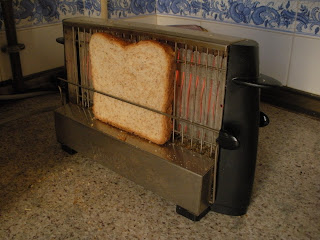
Today marks the end of my second month in Spain, nearly three quarters of that time spent in Sevilla. Needless to say, I’ve begun to settle into a sort of routine.
My first cup of morning coffee made at home was a bit of a challenge. Drip coffee machines are not used in Spain, or really in Europe for that matter. In their place, Spanish kitchens are usually equipped with a moka pot (see photo at left

On days where I get a slow start, I sometimes head straight to the archive and take a mid-morning break para desayunar (eat breakfast). In place of my rather Spartan choice of olive oil and sugar on my toast, the cafes usually offer olive oil, blended tomato paste, and salt. Even more of a treat, the occasional tostada con tomate y jamón serrano (toast with tomato and cured ham) serves as a great start to the morning. Of course, by far and away the very best way to start the morning is by chocolate con churros. That’s right, imagine the Mexican fried dough that is such a staple at street fairs and select dining establishments in the U.S., and you’re not far off from the Spanish varietal. In Spain, churros are served without the heavy coating of sugar common in Latin America along with a large cup of creamy chocolate for dipping...and
drinking.
My days usually begin with a trip to one of several archives in the morning. Like most Spanish busine
Beyond Sevilla, at this point I’ve made it to the beach in the province of Huelva near the Portuguese border for the first three day weekend in October to mark the double holiday of “La Fiesta de la Virgin del Pilar” and “El Día de La Hi
The following weekend I went to a romería, a sort of day-long rural pilgrimage, for the Virgen of Valme. My friend David invited me to see the return of the cavalcade to the parish church in Dos Hermanas. We skirted by car along the outskirts of town in the evening trying to find the festivities in transit to the church, but for much of the time only managed to find drunken revelers encircling bonfires who found it only too funny that we missed the passage of the parade by hours. Giving up on the idea of catching the celebration mid-route, we went into the downtown area to wait. The procession included around thirty oxen drawn carts decorated to the hilt and surrounded by revelers on horse and by foot in traditional Andalusian dress - Flamenco dresses for women and horse riding gear for men. The last ten or so oxen drawn carts were literally mobile bars on wheels dispensing freshly cut slices of jamón serrano, beer and manzanilla. The triumphant return of the Virgen to her resting place within the town church featured fireworks and a tolling of the bells to mark the end of the trek. Sadly, because the trip was rather spontaneous, I forgot to take my camera and so I have no pictures to share.
I’ve also made several day trips to neighboring towns within the Province of Sevilla to visit local municipal archives. I think it best to leave those trips for a future post. Next weekend I’m off to Munich, Germany. I should have photos of the Bavarian capital to share shortly after my return.

No comments:
Post a Comment